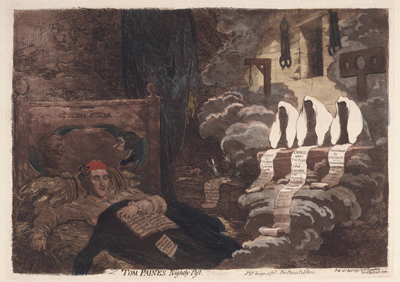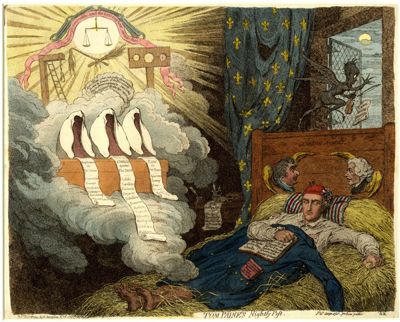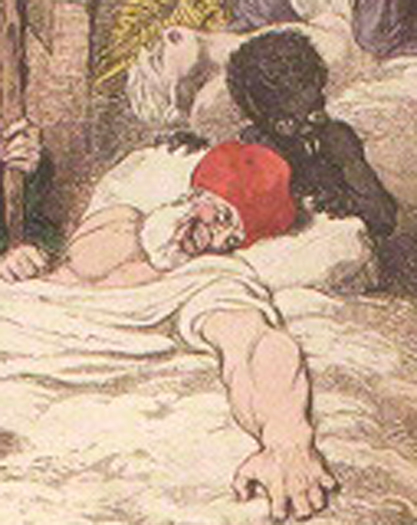Tom Paine's Nightly Pest (2)
Gillray created two versions of this print approximately two weeks apart. The first (shown immediately below) was published on November 26th, 1792, but Gillray's use of aquatint to suggest a darkened room made that print muddy and dark almost to the point of illegibility.

© Lewis Walpole Library, Yale University
His second version was almost certainly created by taking a print from the first one and using it to trace the basic lines of the print on to a new plate. Hence the new version reverses the orientation of the entire print. But this version, without the use of aquatint, is immeasurably cleaner and brighter.

© Trustees of the British Museum
Most of the print is the same as the first version. Paine is shown asleep on a crude bed of straw. As in the first version, his nightcap, with revolutionary cockade, is emblazoned with the word LIBERTAS. On his coat which is being used as a blanket are two volumes lying open which help to identify the figure as Paine. The first is a parody of (and allusion to) Paine's The Rights of Man: "The Rights of Farthing Candles proving their Equality with the Sun & Moon And the Necessity of a Reformation in the Planetary System". The second alludes, once again ironically, to Paine's earlier pamphlet, Common Sense (1776) which was a catalyst for the American Declaration of Independence: "Common Sense or Reason destructive to Free Government." His tri-colored pillow is labeled, "Vive l'America."
The headboard of his bed shows his two English "Guardian Angels" the dissenting Minister and liberal theorist Joseph Priestley and the head of the Whigs and ardent supporter of the French, Charles James Fox. Next to the bed and suggestive of Paine's situation were he still living in England in the fall of 1792 is a rat with his head in a trap. A parody manuscript is visible next to a pen and candle: "The Golden Age. The Age of Equalizing the Property of Princes and Pikemen.
As in the first version, Paine is confronted with a nightmarish vision of trial and punishment, including three faceless judges before whom are listed Paine's pleas, charges, and punishments, with a gallows, chains, and stocks behind. The pleas include "Ignorance, Poverty, Envy"; the charges, "Libels, Scurrilities, Lies, Perjuries, Rebellions, Treasons"; and the punishments, "Corporal Pain, Contempt, and Detestation."
But there are also significant differences in the two versions. The curtain next to the bed is now covered with fleur de lis, suggesting that the room is in France, where Paine had fled from prosecution in England for sedition. The prison-like wall above the bed in the first version has now been replaced with an open window where an affrighted French devil is fleeing with a fiddle in hand and a song sheet for the revolutionary anthem Ca ira. Paine's poverty is emphasized by the holes in his nightshirt which we can now see clearly and by his exposed legs which extend beyond his makeshift coverlet.
But most of the changes occur in the vision of trial and punishment confronting Paine. The light that glowed in the first version from an unknown source now clearly emanates from a bright sun of Justice (suggested by the balanced scales). And a threatening misquotation from Book Two of Milton's Paradise Lost (90-92) now appears in a banner draped over the sun: "The scourge inexorable, and the torturing hour awaits thee" reinforced by the addition of a crossed flail and birch rods. Gillray also includes a speech bubble from the judge before whom the charges against Paine are listed:
Know, villain, when such paltry slaves presume
To mix in treason, if the plot succeeds,
They're thrown neglected by: but if it fails,
They're sure to die like dogs, as you shall do.
As so often with Gillray, the lines are from a popular play in the 18th century—in this case from Act Three of Cato by Joseph Addison. And to reinforce the stronger threats included in this version of the print, Gillray adds one more line to the list of punishments: "Extinction from Society."
Finally, the reversed orientation of this version of the print with the extended hand of Paine grasping at the straw of his bed may recall another traitor also accompanied by a devil, Cardinal Beaufort whose pangs of guilt and fear Gillray parodied in Shakespeare Sacrific'd (1789).

© National Portrait Gallery, London
Sources and Reading
- Commentary from the British Museum on Tom Paine's Nightly Pest
- "Thomas Paine," Wikipedia
Comments & Corrections
NOTE: Comments and/or corrections are always appreciated. To make that easier, I have included a form below that you can use. I promise never to share any of the info provided without your express permission.